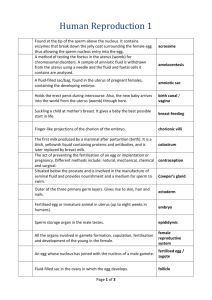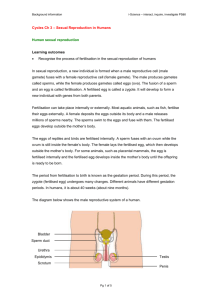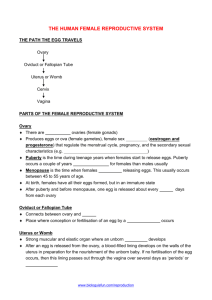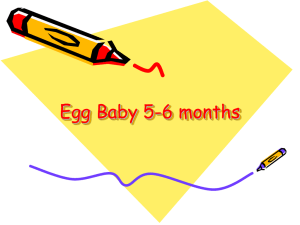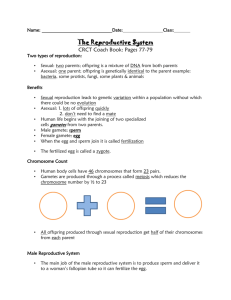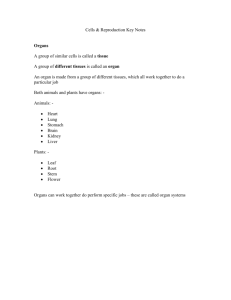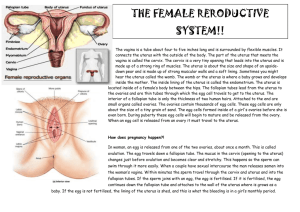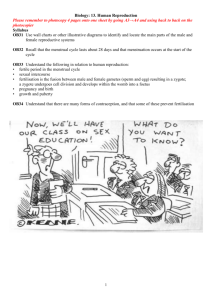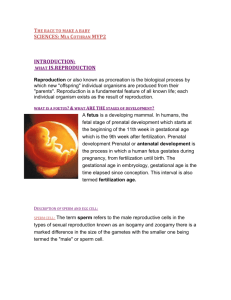The human reproductive systems
advertisement
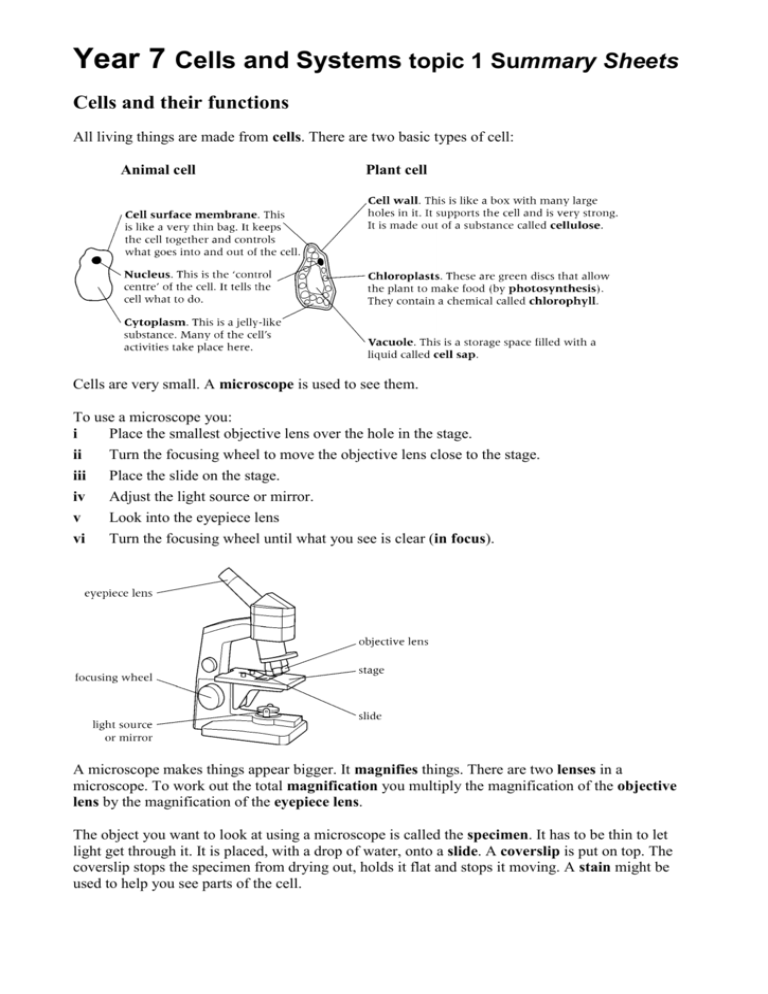
Year 7 Cells and Systems topic 1 Summary Sheets Cells and their functions All living things are made from cells. There are two basic types of cell: Animal cell Plant cell Cells are very small. A microscope is used to see them. To use a microscope you: i Place the smallest objective lens over the hole in the stage. ii Turn the focusing wheel to move the objective lens close to the stage. iii Place the slide on the stage. iv Adjust the light source or mirror. v Look into the eyepiece lens vi Turn the focusing wheel until what you see is clear (in focus). A microscope makes things appear bigger. It magnifies things. There are two lenses in a microscope. To work out the total magnification you multiply the magnification of the objective lens by the magnification of the eyepiece lens. The object you want to look at using a microscope is called the specimen. It has to be thin to let light get through it. It is placed, with a drop of water, onto a slide. A coverslip is put on top. The coverslip stops the specimen from drying out, holds it flat and stops it moving. A stain might be used to help you see parts of the cell. Some cells have special shapes. They are adapted to do certain jobs. Cilated epithelial cells are found in tubes leading to the lungs. The strands at the top (cilia) wave about to move dirt out of the lungs. Muscle cells are able to change length. This helps us to move. Root hair cells in plant roots take water out of the ground quickly. The root hair gives the water more surface to get into the cell. Palisade cells in plant leaves are packed with chloroplasts to help the plant make food. Nerve cells (neurones) are long so that messages can be carried around the body quickly. A group of cells that are the same, all doing the same job, is called a tissue (e.g. muscle tissue). A group of different tissues working together to do an important job makes an organ. For example the heart is an organ and is made of muscle tissue and nerve tissue. Organs have very important jobs: Organs often work together in organ systems. Some important organ systems: Organ system Organs Job Breathing system Windpipe (trachea), lungs Takes air into the body Circulatory system Heart, blood vessels Carries oxygen and food around the body Digestive system Mouth, gullet, stomach, intestines Breaks down our food Flower Stamen, carpel Used for sexual reproduction in plants Nervous system Brain, spinal cord, nerves Carries messages around the body Reproduction Reproduction produces new living things (offspring). In sexual reproduction the nucleus in a male sex cell joins (fuses) with the nucleus in a female sex cell. This is called fertilisation and produces a fertilised egg cell. When fertilisation happens outside an animal’s body it is called external fertilisation. Animals that use this method produce a lot of eggs since some will be eaten by other animals. Humans use internal fertilisation. The fertilised egg cell grows into an embryo and the embryo eventually becomes a new living thing. Sexual reproduction needs two parents. The offspring from sexual reproduction are different from the parents; they are new varieties. The human reproductive systems Humans have reproductive organs so that they can reproduce. The ovaries and testes produce sex cells. Puberty and adolescence The reproductive organs get bigger and start to make sex cells at puberty. This is a time when major physical changes occur in our bodies. These changes are caused by sex hormones. Changes in boys • voice deepens (‘breaks’) • shoulders get wider • hair grows under arms, on face and on chest • pubic hair grows • testes and penis get bigger • testes start to make sperm cells • body smell increases Changes in girls • underarm hair grows • breasts develop • ovaries start to release egg cells • hips get wider • pubic hair grows • body smell increases Adolescence is the time when puberty is occurring and emotional changes happen. It starts between the ages of 10–15 and ends at about 18. The changes start sooner in girls. After puberty, men produce sperm cells for the rest of their lives. Women stop releasing egg cells at the age of 45–55. This is called the menopause. The menstrual cycle The menstrual cycle starts with menstruation (the loss of the uterus lining and some blood through the vagina). It takes 28–32 days for each cycle. About 14 days after menstruation starts, an egg cell is released from an ovary. This is called ovulation. If the egg cell is not fertilised, the uterus lining starts to break down and the cycle starts again. Sex The sperm cells enter the vagina during sexual intercourse. Semen (sperm cells mixed with special liquids from the glands) is forced out of the penis and into the top of the vagina. This is called ejaculation. The semen is moved into the top of the uterus and the sperm cells can swim down the oviducts. Egg cells and sperm cells are adapted to their functions. Pregnancy If the egg cell meets a sperm cell in an oviduct fertilisation can occur. The fertilised egg cell divides to form a ball of cells (an embryo). The embryo travels to the uterus where it sinks into the soft lining (implantation). The woman is now pregnant. Once it has developed all its organs (after about 10 weeks) it is called a fetus. It takes about 40 weeks (9 months) for a fertilised egg cell to grow into a baby ready to be born. This time is called the gestation period. The fertilised egg cells of many animals grow and develop outside their parents. This is called external development. Humans use internal development and produce less offspring than animals using external development since the growing embryos are protected inside the mother. While inside the uterus, the fetus is supplied with oxygen and food by the placenta. The placenta also gets rid of waste (especially carbon dioxide) from the fetus. The cord (or umbilical cord) connects the fetus to the placenta. If a mother smokes, drinks too much alcohol or takes drugs while pregnant she might damage the baby. The baby might be premature. Birth When the baby is ready to be born, the uterus starts contractions and the woman goes into labour. The muscles of the cervix relax. The baby is pushed out head first through the cervix and the vagina. After birth, the baby starts to breathe and the cord is cut. The scar left behind is the navel. After this the placenta is pushed out of the uterus. This is the afterbirth. The baby is fed on milk, often from the mother’s breasts which contain mammary glands that produce milk. The milk contains antibodies which help destroy microbes that might cause a disease in the baby.


